Attribution, the means by which we distinguish the maker of one work from another, is not an exact science but an art. Just because we cannot always explain this act of discrimination, we need not doubt such a power’s existence. Most of us can tell the difference between Van Dyck and Van Gogh or, for that matter, between Beethoven and the Beatles; yet the travails of the Rembrandt Project stand as a warning that the best qualified committees, equipped with the most up to date technology, cannot resolve all doubts as to which canvas is by Rembrandt and which by one of his pupils.
Attribution is a subjective art, for we none of us approach a work with an entirely open mind. Not only are we all born different but each, in a lifetime, will have accumulated different experiences. When I try to understand why and how, from time to time, I have attempted to classify the painting on the istoriato maiolica by date, town or artist, I find myself engaged in a Wordsworthian enquiry into what has formed my way of looking. In doing so I am only too aware of Bernard Shaw’s aphorism to the effect that ‘Experience’ is the name old men give to their mistakes.
In mitigation I can only claim that my own experience began early, before I had even heard of maiolica. Boys tend to collect things and my ‘eye’ received its initial training through trying to keep up with an elder brother and a cousin in our search for shells and caterpillars. Then, as a diplomat’s son, I found myself at the formative ages of twelve to fourteen, in neutral Stockholm during the wartime years 1942-44. There, once a week, an inspired teacher, a Jewish refugee of Polish origin called Wolfgang von Reybekiel, taught me not only the rudiments of drawing and perspective, of handling watercolour and oils, but also a little about Leonardo, Raphael, Michelangelo and Picasso, about impressionism and cubism. Reybekiel’s conversation extended to the possibility of deducing character from the study of handwriting, and to Morelli’s method of attributing paintings by studying finger-nails and ear-lobes. Though the impulse to paint eventually died in me, I retain an admiration for certain paintings that is akin to jealousy.
In 1947 my father’s diplomatic career took him to Rome where, in the holidays from school and Oxford University, I extended my love of Italian renaissance art. Between school and university I did compulsory military service, part of which I served in Trieste, all of which gave me a certain fluency, alas not matched by grammatical accuracy, in the Italian language, It was, however, only in 1955, when I obtained a job in the Works of Art and Ceramics Department of Sotheby’s, that I began to apply all these experiences to istoriato maiolica.
What is istoriato maiolica? The short answer is that is is tin-glazed earthenware decorated with stories. Most Italian maiolica of the sixteenth century was not decorated with stories or figures, but with simple geometric or floral designs. Dig up a maiolica kiln-site anywhere in Italy, even at Urbino, and you will find among the sherds only a tiny minority of istoriati. Yet this category, initially rare, has survived better than its cheaper contemporaries because from the start it has been prized, soon retired from use at table and placed in cabinets or even framed and hung on walls.
At the time I joined Sotheby’s, courses in art history had not yet sprung up all over Great Britain, sometimes in towns where precious little art is to be seen. For the applied arts there was (and perhaps still is) no better way of learning than by handling objects at the auction sales. I was fortunate enough to work at Sotheby’s under two of the greatest connoisseurs of the day: A.J.B. Kiddell and T.H. Clarke. From Jim Kiddell I learnt that ceramics should be studies under natural, and preferably overhead light. One hopes this lesson will not have been forgotten when the top-lit ceramic galleries of the Victoria and Albert Museum are finally reopened to the public.
Since I could read Italian, most of the Italian maiolica and sculpture that passed through Sotheby’s soon tended to come to me for cataloguing. When I look back I am frightened to think of the mistakes I must have made. Few books were then available, and amongst these the most useful was Bernard Rackham’s great Catalogue of Italian Maiolica in the Victoria and Albert Museum.
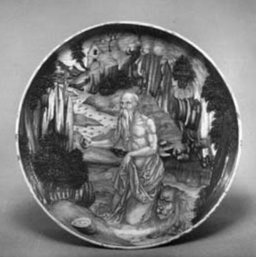
On one occasion a dish on low foot bearing the initials ‘F.R.’ came my way (Figure 1) and I wrote to the great man himself (though I was never to meet him), receiving a courteous handwritten reply pointing me towards an article he had written jointly with Gaetano Ballardini in 1933, and warning me that, as he has argued in a more recent paper, this Faentine painter was not to be confused with Francesco Xanto Avelli. It has taken me a lifetime to unravel to anything like my own satisfaction the various conundrums associated with F.R. and Xanto, who are now generally accepted as being a single person who spent his life working in the Duchy of Urbino.
The composition of St. Jerome and his lion in the wilderness on Figure 1 is based on an engraving by Durer, and therein lies a factor to consider when attributing Italian maiolica: it is necessary to distinguish between those elements in composition and handling that may derive from a print, and those that are original to the maiolica painter. Often a maiolica painter will allow himself considerable liberty in his handling of a landscape background, while sticking close to an engraved model for the figures. Also, since most plates are circular and most prints rectangular, a mailoica painter often has to make personal choices towards the periphery as he adds to the composition or omits parts of it in order to fit the design to the shape of his vessel.
When first faced with the ‘F.R.’ St. Jerome dish, and before I had heard from Bernard Rackham, a look round the maiolica displays in the Victoria and Albert suggested to me that its pale colours and emphatic tonal contrasts had more in common with the painter then known as ‘Pseudopellipario’ but now known as ‘the In Castel Durante Painter’ by reason of the inscriptions to that effect that he placed on a number of pieces dated between 1524-26. We now know Rackham was wrong in attributing the work of ‘F.R.’ to Faenza, but equally I believe I had been on the verge of making a beginners’ mistake in trying to identify place of production on grounds of colour alone.
First plaques and tiles are the exception in maiolica, and plates fall into a variety of forms no doubt connected with the purpose each was originally designed to serve. One of the ways in which attribution of maiolica differs from attribution of drawings or paintings is thus due to maiolica’s three-dimensionality. The shape of a foot-ring can suggest a district of production or put one on one’s guard as to as possible spurious piece.
The ceramic body and the glaze of maiolica tend to vary from place to place and from period to period. My old mentor, Jim Kiddell, was right to encourage examination under daylight conditions, which are more revealing of colour and texture than tungsten- or strip lighting. Of course new laboratory techniques, such as thermoluminescence or analysis of clay samples are now available to help determine age, authenticity and place of production, but these tests can be expensive and disfiguring. Pieces subjected to thermoluminesence have occasionally yielded different results on being re-tested, and clay analysis will have to take account of the way potters did not always use local clay. As the mid-sixteenth century writer, Cipriano Piccolpasso, explained: “Venice works the clay of Ravenna, and for the best of that of Pesaro.” Neither thermoluminesence nor clay analysis can distinguish the hands of two maiolica painters who worked at the same time and place.
Occasionally a piece will appear for which one’s previous experience has not prepared one, and one does well to subject such a piece to the sharpest of scrutiny. Towards the end of my time with Sotheby’s such a piece turned up, a circular plaque attributed to Cafaggiolo and painted, in a manner based on Durer, with the Holy Family (Figure 2).
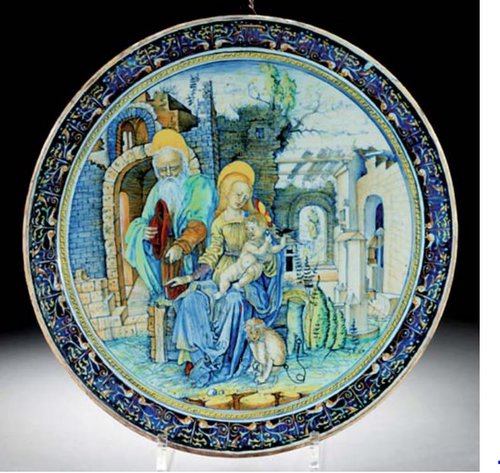
It was included in that most select of small collections, Sir Stephen Courtauld’s, but besides being of an unusual shape, it had an exceptionally shiny white glaze and a startling brilliant red pigment appeared here and there in its decoration. Despite this, I at first inclined to think the plaque genuine, but was overwhelmed by the certainty with which both Jim Kiddell and Tim Clarke pronounced it a fake, most probably by Ferruccio Mengaroni. Accordingly it was not sold with the rest of the collection, and the Courtauld family yielded it to Kiddell’s collection of fakes. In 1990 the Courtauld roundel was echibited in Fakes and Forgeries. An Exhibition Incoporation Sotheby’s Black Museum, at the Olympia Antiques Fair, the anonymous author of the handbook declaring: “It is difficult today to see how all the experts at the time could be fooled by the fussy yet stiff border or the strange polychrome palette of the painting.”
Meanwhile, in 1962 I had joined the Ceramics Department of the Victoria and Albert Museum, which gave me unrivalled opportunities to handle maiolica both there and in other collections. In storage at the British Museum I examined a dish, also derived from a Dürer engraving and attributed to Cafaggiolo, that shared the physical characteristics of the Sir Stephen Courtauld roundel to such an extent that I seriously wondered if it too was not a fake (Figure 3 and 4).
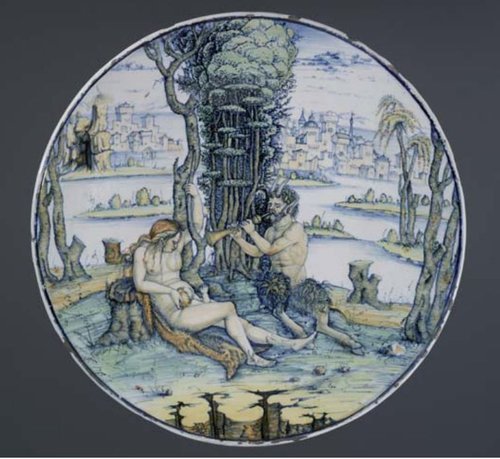
This plate, however, had been acquired at the Bernal sale in 1855, long before Ferruccio Mengaroni and most other forgers of maiolica were active. The pattern on its reverse (Figure 4),
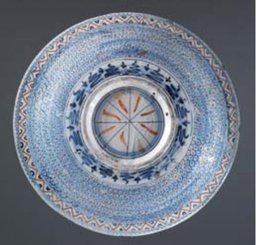
besides including bright red pigment, was clearly related to several other plates of undoubted authenticity, including one in the Schlossmuseum at Stuttgart. By the time I had become seriously intrigued by the possibility that the Courtauld roundel might after all be genuine, it had been stolen from Sotheby’s. Would we ever learn the truth about it?
You may imagine my keenness to see this piece again when Sebastian Kuhn of Sotheby’s told me, a year or two ago, that the roundel had resurfaced. Would it prove, in the light of all I had learnt in the interim, to be genuine after all? My first contact with it, after all those years, was disappointing. The reverse is unglazed and offered no comfort to a doubter such as I had once more become. To my chagrin I was unable, due to a prior engagement, to attend a session at which Timothy Wilson and Dora Thornton were able to compare the Courtauld roundel (Figure 2) with the British Museum dish (Figures 3 and 4), on which occasion they both became sat-sfued that the roundel us genuinem a verdict subsequently confirmed by thermoluminesence. The roundel was therefore offered to the heirs of Sir Stephen Courtauld, who expressed an intention of placing it in the Palace at Eltham formerly occupied by Sir Stephen and his wife.
Though evidently genuine, the Courtauld roundel’s attribution to Cafaggiolo, in Tuscany, is anything but certain, as yet unconfirmed by archaeology or by comparison with marked or dated examples. It belongs to a rare category whose place in the history of maiolica has yet to be established. There were therefore few pieces with which it could be matched. When one enters the Marches, the classic land of 16th century istoriato maiolica, the problem is rather that there are so many pieces between which one can make comparisons.
In such a circumstance it has always seemed to me wise to try to identify first the best and most influential painters, isolating them from accretions of works by lesser hands that tend to stick to the most desirable names. There is also the possibility of collaboration. It has long been understood that pieces completed in polychrome at Urbino, were sometimes sent up to Gubbio, where they received decoration in gold and red lustre and were refired in a specially designed kiln. Maestro Giorgio Andreoli and members of his family at Gubbio specialised in adding value to pieces by this means. It is sometimes hard to determine which istoriato pieces were both made and lustered at Gubbio, but relatively easy to spot pieces, usually from the 1530s, to which lustre pigments have been added in ways not anticipated by the original painter. Pieces ‘Clobbered’ in this way with shiny metallic brush-strokes, often including a meaningless lustred sun, are among the least appealing of all istoriato wares. In trying to attribute Urbino istoriati it is ofern necessary to imagine how a piece would have looked before it received the unwanted attentions of Maestro Giorgio’s lustre workshop.
A more complex issue is raised by collaboration between a painter and his pupils or followers. Oddly enough I seem to have been the first writer to raise this possibility in the context of maiolica when, in 1971, I wrote of Xanto and his followers in the magazine, Apollo:
The possibility that a piece of maiolica might be painted partly by one painter and partly by another is never raised save in those instances where Urbino ware is thought to have been sent to Gubbio to have listre pigments added at a separate final firing. Now in seeking to determine the authorship of an Italian renaissance panel-painting, even a signed one, no reputable modern art-historian would fail to consider the possibility of collaboration between artists working in a given studio. From a sketch in Cipriano Piccolpasso’s treatise we know the conditions in which maiolica painters worked. In this sketch we see a number of painters grouped round a circular table, with the same prints and drawings pinned to the wall for all to copy. Nothing seems more likely from the grouping of the painters in the studio than that pieces might from time to time be passed for inspection or completion from a less skilled workman to a more accomplished master, or that a busy master might pass a piece on which he had drawn the figures to an inferior painter who was deemed capable of filling in details of the background.
One might think that Morellian methods- the close study of fingers and ear-lobes – might offer the surest way out of the dilemmas raised above. Howeber I recall being taken years ago by Timothy Clifford to visit, in the basement of Sotheby’s, that great attributionist of Italian renaissance drawings, Philip Pouncey, who ruminated somewhat as follows about the experience of his life-time: “When I approach a drawing first of all through its details, I always go wrong, Instead, I try to form an idea of the artist’s personality, of what he knows and doesn’t know. Only then do I look for confirmation through the details.” I have found this advice excellent when applied to istoriato mailoica.
The case of Nocila da Urbino should be a warning to all of us who attempt attribution of istoriato maiolica. During my working lifetime so many old beliefs about this man have crumbled, that it is still hard to perceive the character of his work through the cloud of dust the demolition-men have raised. Just for a start, we may no longer call him Nicolo Pellipario, nor suppose his early work executed in Castel Durante, let alone at Ravenna and Fabriano. Nor, any longer, do we believe Guido Durantino to have been his son. Instead, we now have to think of him as Nicola di Gabriele Sbraga (or Sbraghe), a native of Urbino, already described as Magister in 1520, and hence probably already the possessor of his own workshop in that town. He was certainly head of an Urbino bottega in 1530 when we find him combining with fellow master-potters to resist some skilled craftsmen (including Francesco Xanto Avelli) who were trying to obtain higher rates of pay. Nicola was still in Urbino in the winter if 1537-38, when he died, and there is no reason to believe he had ever worked anywhere else.
I believe most scholars now agree that we must subtract from Nicola’s oeuvre almost all the pieces painted with grotesques and all those with heads of beautiful women and heroic men, with which Otto von Falke encouraged ceramic historians to credit ‘Pellipario’. We may also deny Nicola’s authorship of a series of dishes with blue strapwork surrounding a monochrome figure subject.
I have myself robbed Nicola of some attractive istoriato wares by attempting to define the oeuvres of two painters whom I named the ‘Milan Marsyas’ Painter and the Painter of the ‘Apollo Basin’. These names, allotted to groups of wares by otherwise anonymous painters, are linked to specific works, available for comparison in public collections, on the model of the ‘type specimens’ of natural history. I have grown wary of attributional groupings based on subject-matter, for instance of Rackham’s creation, the ‘Master of the Myths in Modern Dress’, for whom there is no central work by comparison with which further attributions may be justified or rejected.
When we survey what work remains attributable to Nicola, we have to re-examine the pieces allegedly ‘signed’ by him. To these, mercifully, an invaluable addition has been made in recent years. A dish at Novellara with The Finding of the Cup in Benjamin’s Sack is the only piece known where the signature claims to be that of the painter: “Ioni Chola pinstt” (I Nicola painted it). The handwriting on this is assuredly the same as that on several other pieces bearing Nicola’s name, initial or monogram, but when we remember Nicola was the proprietor of a workshop, it has to be admitted that such inscriptions are not proof that he painted the piece himself.
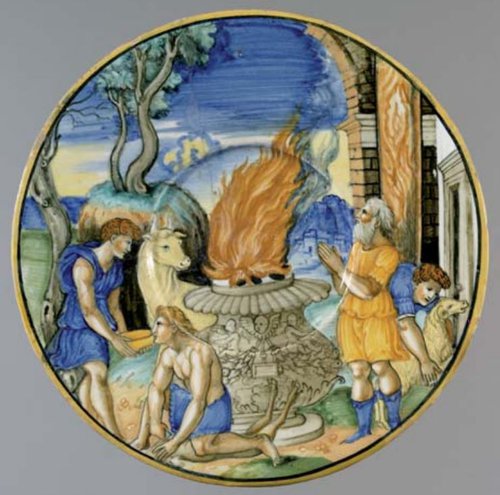
A particularly worrying example of this danger is a plate in the British Museum (Figure 5). The inscription on the underside (Figure 6), written in what appears to be Nicola’s chancery hand, seems clear enough, concluding with the name Nicola da / .V.. Yet the scene on the upper side so lacks the qualities we recognise and value even in Nicola’s late work, that I for one have little hesitation in assigning the British Museum’s piece to some inferior hand working in Nicola’s studio.
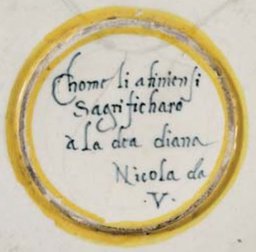
One of the things Nicola’s more certain work never loses, even when his touch coarsens in the mid 1530’s, is an amazing tact in handling the spatial possibilities offered by the depression at a plate’s centre, a skill much missed on Figure 5. A sinuous flexibility of line runs along the limbs of Nicola’s figures, animating their wrists, fingers and feet, all of which are stiff and inert on the on the Nicola da .V. plate. The faces on that, too, are inexpressive and do not conform to the range of types found on works and more characteristic of Nicola.
Figure 7 (c) Copyright The Trustees of the Wallace Collection
Figure 8 (c) Copyright The Trustees of the Wallace Collection
Figure 7. Plate, The Chariot of Juno, the arms of Federico Gonzaga, Marquess of Mantua and his wife, Margherita Paleologo of Montferrat. Diam. 10 3/4in., (27.4cm). Urbino, Nicola da Urbino, ca. 1533 (c) Copyright The Trustees of the Wallace Collection
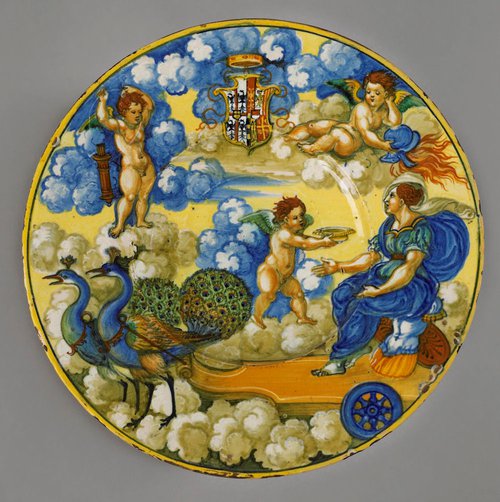
The plate in Figures 7 and 8 cannot, by reason of its Gonzaga-Paleologo arms, be earlier than 1531, the year the persons concerned were married, and it was probably of the same date, 1533, as a dish by Xanto in the Victoria and Albert bearing the same arms. For such important clients it is unlikely that Nicola would have entrusted a piece to a pupil, despite apparently delegating to Xanto the Victoria and Albert’s large dish. The Gonzaga-Paleologo plate, then, should be roughly contemporary with Figure 5, yet how different is the artistic personality revealed by it!

On Figure 7 the cupid who proffers a dish to Juno floats in a different and somehow more distant zone than the Goddess’s chariot; her arm, far knee and the tails of her peacocks stretching out into this mysterious central space. The trick has nothing to do with aerial perspective nor with linear perspective and reduction in scale, since the cupid proffering the dish is of the same size as the other two on the plate’s border. Such a trick is typical of Nicola, sometimes achieved by architecture, sometimes by a satisfying yet quite un-naturalistic grouping of hillsides, and it is a trick that Xanto, for instance, never quite understood.
In attempting to isolate the distinctive qualities of a painter, I have referred only in passing to the subjects depicted. Of course the way a painter sets about narrating his istoria can reflect his personality, his style. Yet it is no accident that the pioneers of attribution grew up in an age of aestheticism when design, composition and representation of form were pre-occupying critics of art, even before artists conceived the possibility of abstract and non-representational paintings and sculptures. Formalist criticism, with its catchwords and phrases like ‘tactile values’, ‘space-composition’ or ‘significant form’, is a better basis for observing differences between one painter and another than the study of iconography or social messages. I don’t wish to belittle studies of the latter kinds, which can add immeasurably to our appreciation of art; I merely point out that they are seldom of much use for the purposes of attribution, which is the subject of the present paper.
You will have noticed in the forgoing paragraphs, a struggle to characterise, in words, observations which, of their nature, are visual. You will say such characterisations are entirely subjective, and I shall agree. At least, I shall plead, I have not resorted to the use of such learned-sounding words as ductus which, if it means anything at all, depends on observations as subjective as my own. Judgements of style are opinions, not facts, and however clearly we think we can recognise a painter’s style, we shall often be disappointed to find that others, looking at the same piece or pieces, judge quite differently.
Where a judgement is so personal, so hard to defend, there is a temptation to protect our own perceptions by decrying the understanding, the taste, the motivation of those who disagree with us. I would like to conclude, therefore, with advice from that saintly Anglican man of the cloth, the seventeenth century poet, George Herbert:
Be calm in arguing: for fierceness makes
Errour a fault, and truth discourtesie.
Why should I feel another mans mistakes
More than his sickness or povertie?
In love I should: but anger is not love,
Nor wisdom neither: therefore gently move
(c) Copyright J.V.G. Mallet 2007

